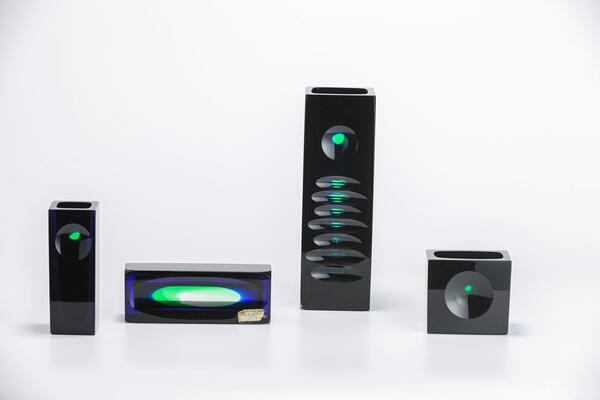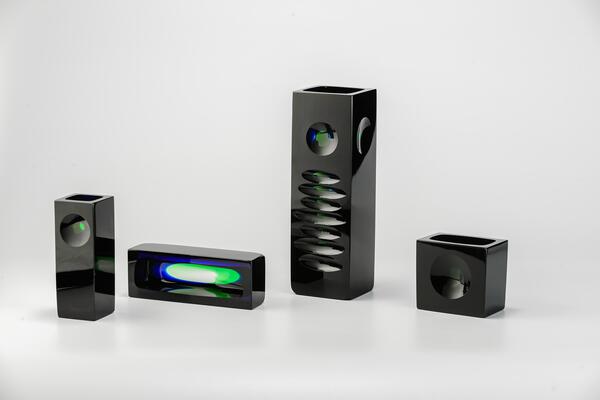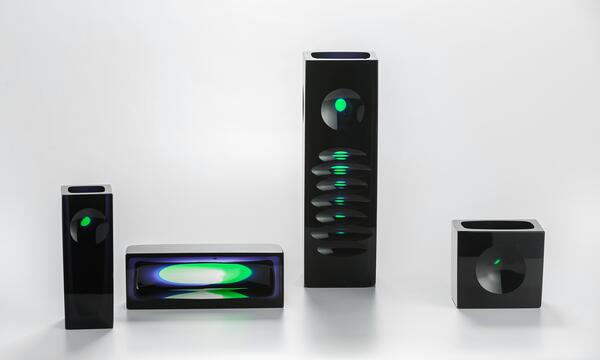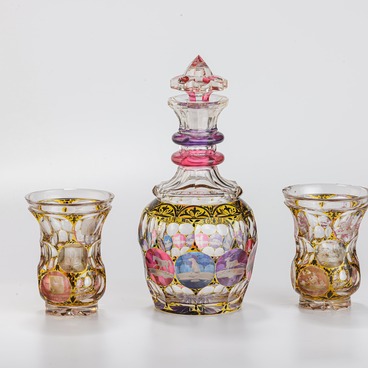The first viewers who saw “Moonlit Night on the Dnieper” by Arkhip Ivanovich Kuindzhi believed that the picture was painted on glass, and the amazing glowing effect was caused by a source of artificial illumination that had been placed inside. A century later, the painting was embodied in the crystal composition of Anatoly Shvedov.
The artist used three-layer (colorless, green and cobalt) crystal. The composition consists of four prism-shaped objects that differ in size. Their contemplated mutual arrangement, as well as the combination of emerald, black-green and dark blue colors create the effect of space and depth.
All the details of the composition are made with the help of the “silent blowing” method, when blowing occurs without rotating the glass in the mold. Such products are called “quiet”.
Grinding also plays an important role in creating parts of the composition. Large pits in the upper part of the high rectangular cuboid, arranged in a mirror-like manner, are polished to a green color. Under each of the pits, opposite each other, there are polished horizontally elongated ovals, which create the illusion of a moonlit path on the river.
In addition, large pits on opposite sides of two cuboids were polished to green. On the last elongated item, the oval-shaped cut reveals colorless crystal.
The canvas by Arkhip Kuindzhi, which formed the basis of the composition, is very laconic, but the many shades of black and green create a feeling of space and changeability. To create the “glow” effect, the artist used bituminous (or the so-called asphalt) paints.
Anatoly Georgievich Shvedov graduated from the Abramtsevo School of Industrial Art and became a professional artist. He devoted 20 years to work in the experimental art workshop of the Red Giant factory, and manufactured a lot of original products. The artist participated in numerous regional, republican and international exhibitions, and was a four-time bronze medalist at the VDNKh exhibitions in the USSR. “Moonlit Night on the Dnieper” (dedication to Kuindzhi) is considered by art historians to be the pinnacle of Anatoly Shvedov’s work.
The artist used three-layer (colorless, green and cobalt) crystal. The composition consists of four prism-shaped objects that differ in size. Their contemplated mutual arrangement, as well as the combination of emerald, black-green and dark blue colors create the effect of space and depth.
All the details of the composition are made with the help of the “silent blowing” method, when blowing occurs without rotating the glass in the mold. Such products are called “quiet”.
Grinding also plays an important role in creating parts of the composition. Large pits in the upper part of the high rectangular cuboid, arranged in a mirror-like manner, are polished to a green color. Under each of the pits, opposite each other, there are polished horizontally elongated ovals, which create the illusion of a moonlit path on the river.
In addition, large pits on opposite sides of two cuboids were polished to green. On the last elongated item, the oval-shaped cut reveals colorless crystal.
The canvas by Arkhip Kuindzhi, which formed the basis of the composition, is very laconic, but the many shades of black and green create a feeling of space and changeability. To create the “glow” effect, the artist used bituminous (or the so-called asphalt) paints.
Anatoly Georgievich Shvedov graduated from the Abramtsevo School of Industrial Art and became a professional artist. He devoted 20 years to work in the experimental art workshop of the Red Giant factory, and manufactured a lot of original products. The artist participated in numerous regional, republican and international exhibitions, and was a four-time bronze medalist at the VDNKh exhibitions in the USSR. “Moonlit Night on the Dnieper” (dedication to Kuindzhi) is considered by art historians to be the pinnacle of Anatoly Shvedov’s work.





